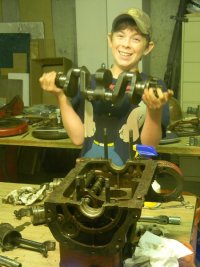wesail&ubail
Inactive Member
| My son and I are rebuilding a 32-2 that he bought for $1.00. The boat slipped its mooring and stove up on the rocks in Connecticut a handful of years ago. The dozen or so holes are now patched nicely but there seems to be a large hollow section aft of the lead ballast in the keel- is this normal? At various times throughout repairs tiny round lead shot would roll out from the gash in the bottom of the keel - I assumed that this was poured in over the top after the lead was set into the keel hollow, to bed the lead. The question is; was there a hollow section in the keel aft of the lead? Was it filled with shot? That would be a very large volume to re-fill. I assume if I leave it empty, it will inevitably fill with water and then freeze when we pull the boat each winter - causing a catastrophic blow out. Should we fill it with low expansion foam? Lead shot? There is a big difference for ballast effect here. Does anyone know how it was originally constructed? Thanks so much. Jay and Ebben |
<tbody>
</tbody>

